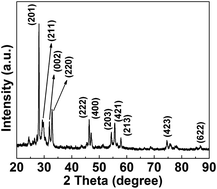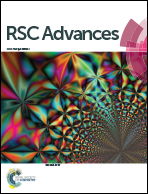The facile preparation of a carbon coated Bi2O3 nanoparticle/nitrogen-doped reduced graphene oxide hybrid as a high-performance anode material for lithium-ion batteries†
Abstract
A hybrid of carbon coated Bi2O3 nanoparticles distributed on nitrogen-doped reduced graphene oxide is prepared by facile thermal treatment processes. In this hybrid electrode material, the nitrogen-doped reduced graphene oxide improves the electron and Li+ transport due to its good electrical conductivity and surface wettability. In addition, the carbon coating layer avoids direct contact between the Bi2O3 and electrolyte, so it effectively inhibits the repeated formation and decomposition of a solid electrolyte interface film. Furthermore, Bi2O3 nanoparticles can improve the Li+ diffusion because of the short Li+ diffusion distance. As a result, the hybrid has stable cycling retention (391 mA h g−1 after 250 cycles at 3 A g−1), and outstanding rate capability (326 mA h g−1 at 4.8 A g−1). The excellent electrochemical performance is associated with the synergistic effect of the highly conductive nitrogen-doped reduced graphene oxide matrix and carbon coating layer. The excellent lithium storage capability indicates that the hybrid of carbon coated Bi2O3 nanoparticles distributed on nitrogen-doped reduced graphene oxide has significant potential as an anode for lithium-ion batteries.


 Please wait while we load your content...
Please wait while we load your content...